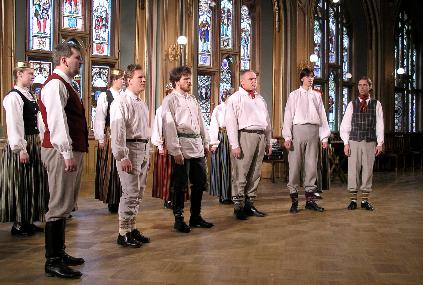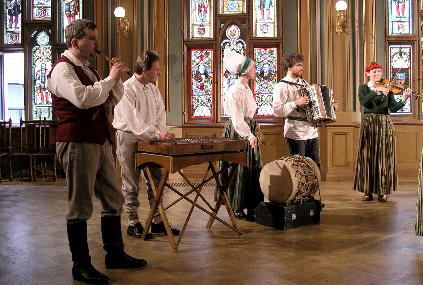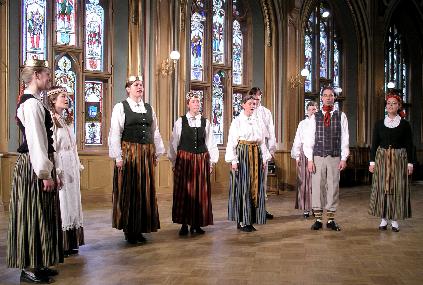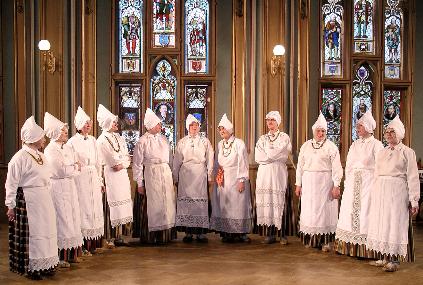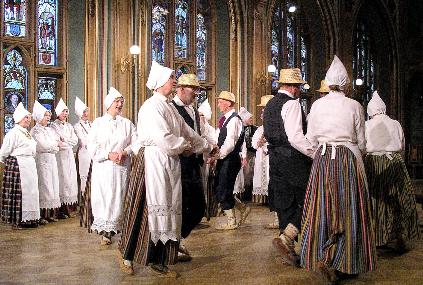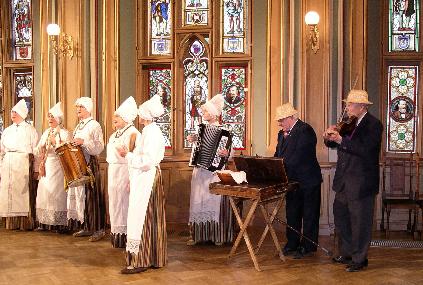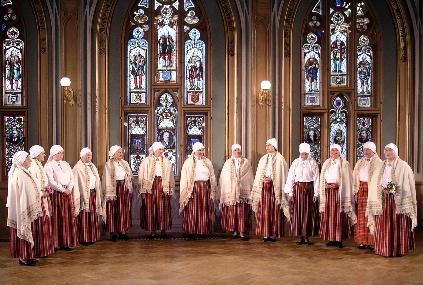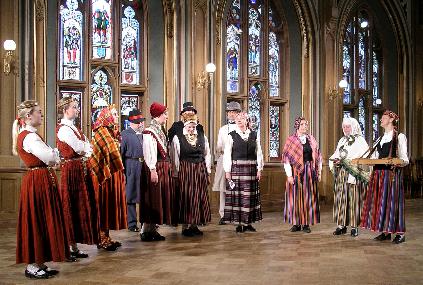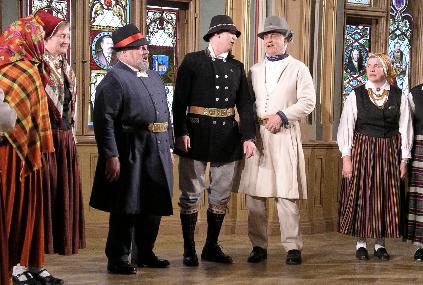|
|
|
|
|
Folklore groups
Instruments Activities About us |
|
|
|
Calendar
Regular Reportings Education |
|
|
|
Support
Fonts Mpeg3 Links Addresses Statistics Guestbook |
|
|
|
You are visitor of folklora.lt and visitor of this page. |
|
St. George's Day Concert "I am weaving a belt for St. George",
On April 25th 2004 a folklore concert dedicated to St.George's day took place
in the Small Guild in Riga.
The evening's hostess, Ieva Bērziņa, opened the concert with the words that
"Juris, Jurģis and Ūsiņš are different mythological figures" but added that
this time the emphasis would be on their common characteristics
(Juris, Jurģis: St. George, celebrated in Christian calendar April 23rd;
Ūsiņš: Latvian deity linked with spring and light (patron of horses)). The
participants were invited with the aim of representing each region of Latvia -
the traditional division of Riga, Livland, Latgalia, Semgalia and Kurland.
The introduction of each ensemble came with a repeated reminder of the
"different mythological figures" with encouragement to demonstrate/perceive
the entire spectrum of traditions. However, each group clearly expressed its
understanding of regional folklore traditions and materials without needing
much encouragement.
The concert began with a joint performance of two groups from Riga -
Zvīgzna and
Maskačkas spēlmaņi
(musicians from the Riga suburb of Maskachka). The men and
boys sang first and the tune was in many ways misleading - this was followed
by a medley of melancholy popular songs albeit with the addition of witty
lyrics. However, the obviously theatrical layout of the performance - the
singers standing in sparse lines behind one another, like a choir facing the
audience - and the "standing to attention" stance of the majority of them -
created more of a school exam atmosphere than one of young people's joy about
the arrival of summer. When the band began to play it seemed appropriate for
dances to commence but the music turned out to be just another sugary
addition.
The formal formation gradually made way for a livelier scene when everyone
formed a circle to do a dancing game - a summery version of chase. Although it
wasn't much of a chase due to the setting and slippery floor, the youngsters
moved and sang from the heart, without worrying too much about keeping in tune
- this naturalness was what had been lacking in the rest of the programme.
(There is something to be said for the literal meaning of the phrase "a
shoulder to lean on" - which is why we shouldn't be shy about taking a friend
by the hand on stage, if it's done in sincerity then everyone will benefit).
The song What a good life boys have also came across well and sounded
sincere. And at the end of the day, a dose of timidity and lack of conviction
is one of the values of youth. Young people demonstrating traditional culture
with the attitude of theatre professionals would come across as more vulgar
and unacceptable than manifestations of natural shyness.
As a contrast to the "staged" performance of the young people from Riga, it
is precisely the confidence that comes with years of experience that was
demonstrated by the group Rota from Renceni. From the very beginning
they managed to take over almost the entire space and emotionally "hold it"
throughout their performance.
The women began with a theatrical display, demonstrating a variety of beliefs
specific to St. George's day. They warmed to roles quickly and any initial
stiffness soon disappeared and the audience responded well. As part of their
performance they went round with a smoke can wafting the smell of burning wood
onto the audience and appealing to people's sub-consciences, reminding them
about their connection with bees, the sun and summer. Putting their
theatrical attributes to one side, the group gradually came together and sang,
freeing themselves of the theatrical gestures involved in the previous
performance. (The singers stood in a semi-circle and addressed the audience
but didn't miss an opportunity to demonstrate their ability to address each
other). The songs sounded natural, well practiced as though they had been
used in various situations.
The musicians began to play, the men joined the group and dancing commenced.
Those left without partners sang and kept the rhythm, one or two of the
dancers and musicians also sang along and a "voluntary" principle emerged - if
you want to show your soul, do so, if not, everyone can see it just the same.
Once again, the age of the participants was demonstrated in the conviction
that it didn't matter.
Women of the Shkylbani ethnographic ensemble was present in full force.
Their introductory speech noted that they represented a region very active in
the maintenance of traditional culture, paid homage to old song-tellers and
also introduced new group members. They devoted a range of songs to life,
spring and traditions associated with St. George celebrations. They sang
songs from their region, some of which are still used today by ordinary folk
as they go about their daily activities. (It was a shame that no "archaic"
voices from the past could be present, as they would have been appreciated by
people knowledgeable in folklore). As an obvious contrast to the previous
performance by the group from Renceni, the Shkylbani women's actions seemed to
contain underlying secrets known only to them, and that revealed to the
audience was only the vocal "surface". Their semi-circular formation was
almost flattened against the wall furthest away from the audience but with an
inner tension underlined by the hook-like bends at the end of the formation.
Nearly every exchange of looks and body movement reflected the logical
structure of the songs with instinctive preciseness. Seeing something like
that - unknown and deep - one is taken over by fear every time that it can all
be destroyed in an instant, the singers subconsciously submitting to the
general desire of becoming "available to a wider audience" and getting carried
away with the fine-tuning of the technical side of the music, neglecting the
human side.
The group from Svitene came onto the stage energetically singing popular
songs and beating a rhythm. However, this introduction also proved to be
misleading - as a continuation the audience were invited to imagine the
beginning of summer in Semgalia as witnessed and described in the book
Straumēni by E.Virza. The chosen lines read in harmony with the singers'
songs occasionally really did manage to conjure up a magical atmosphere in the
spirit of the cited writer, but unfortunately the mood was not retained
through to the end. Many of the songs were sung as choir variants robbing the
performance of its desired mysteriousness, in one of the song endings
magnificent Slav octaves "appeared", in turn those songs that were nearer to
ethnographical singing weren't even attempted to try and fit in - some of the
song-tellers were hidden behind the others' backs and the words were often
inappropriate for their age, gender and status; the song-tellers also changed
with no good reason halfway through a "four-liner". Occasionally it appeared
almost as though the "choir" standing in two lines behind each other, with
their last strength turned towards the audience desperately trying to tell
them something. After the dancers came onto the stage, the false line-up of
the singers wasn't renewed. One or two of the soloists were invited to the
middle, including a young boy who turned out to be one of the most convincing
Svitenes singers and whose face seemed to say, "Why are they struggling, is it
really that difficult?"
The group Laipa from Ventspils said to represent "robust folk from
Kurland" (in all honesty, this was in response to jibes from other regions'
representatives) but their "robustness" sounded more like sparrows being shot
by cannons: lack of mutually coordinated activities and no advantage taken of
the potential of the group members. The emotional link - communal singing -
was held in separate duos/trios who stared fiercely at the rest of the group
as though to say "What are they going to do?" The leader continuously shifted
nervously, unsure whether to lead the others with her eyes or to go to the
front and show herself off. The men were "cordoned off" from the audience by
a line of female singers - when they were allowed to stand at the front to sing
a few tuneful songs, the leader looked visibly worried, wondering what the
outcome would be. We could excuse the folk from Ventspils as having a "black
day" (which can happen to anyone or any group) and for apparently not having
rehearsed their performance. However, they tried to redeem the situation by
singing, overall weakly, songs from all corners of Latvia, that have been
well-known throughout Riga's folklore circles for 15 years. Here it was
completely remiss of them to introduce these as "little-known songs to be
sung, as befits a folklore group". In a way, we can understand why a group
that often performs in non-folklore settings might have "drilled" themselves
to take on a theatrical "montage", however, their nervous hand gestures and TV
show intonations weren't appropriate and even annoying. This wasn't the right
audience to try and fool. At least some of the individual group members had
the taste, self-respect and tact not to overdo their performance.
As their finale, Laipa invited the other groups to join them in a
roundelay with audience participation and at least the popular I had a
wager with the sun was a good start to the remaining dances.
The Maskachka's musicians played the accompaniment, joined by the musicians
from Renceni. The audience was responsive and the last hour was spent doing
dances and dancing games. In this way, the overall poor performances were
forgotten in the simple, heartfelt enjoyment of being together. Of course,
those present were grateful for the hosts' provided tasty food. Even the
props used by the group from Renceni - peas, used to illustrate a folk tale -
were eaten by everyone.
Article: Anete Simanovska, April 27th 2004 |
|
Questions, comments and suggestions are welcome to ansis_N@N_folklora.lt This page is created with support of SFL, Latnet and Lanet. |
|
03 September 2018 |
